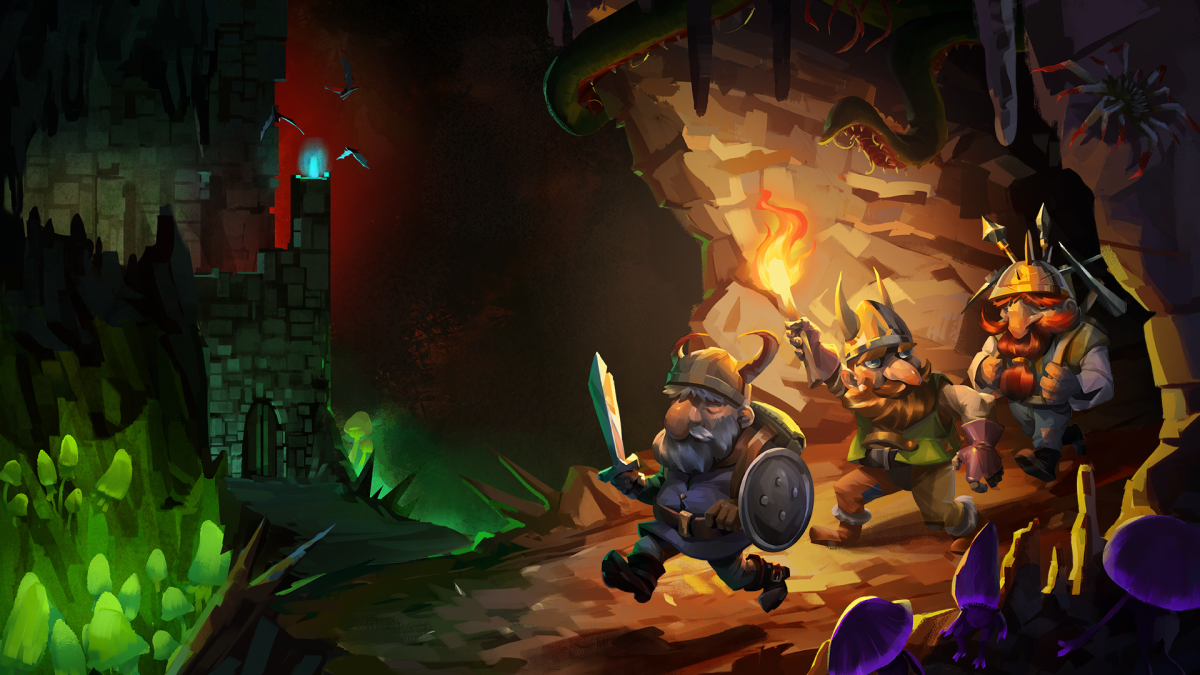Dwarf Fortress Review
🌐
need to know
what is it? A procedurally generated colonial sim masterpiece.
Expect to pay: $30
release date: December 6, 2022
Developer: bay 12 games
Publisher: Kitfox games
commented on: i7 8700k, Nvidia GeForce 3070 RTX
multiplayer game? Do not
Association: Steam Page(opens in a new tab)
In playing Dwarf Fortress for more than 13 years, I have witnessed my share of legends. I have witnessed the one-armed dwarf general slay the ancient dragon. I watched in horror as an artisan emerged from months of being trapped in the cavern beneath the halls of my stronghold, clinging to life just long enough to craft one final piece: an obsidian and bone puzzle box. Now that I see Dwarf Fortress hitting Steam, the colony sim’s emerging storytelling is more approachable than ever — but that’s about it.
The ever-evolving life work of sibling developers Tarn and Zach Adams, Dwarf Fortress is entering a new era, shedding its text-based graphics for basic modernity with proper pixels and native mouse support. For those willing to delve deeper, Dwarf Fortress remains mysterious, still magnificent, and remains an unrivaled treasure trove of procedural mythology.
hit the earth
At its most basic level, Dwarf Fortress is a settlement sim. Together with a small group of dwarves, you set out from your mountain home to take your place in the remote wilderness. It’s up to you to build a fort from the ground up or down, in typical dwarven fashion, that will last. Winter is only a few months away. Start digging.
At first, Dwarf Fortress seems simple. Clunky to control, perhaps, but when you’re marking out tunnels to mines and chopping down trees, it seems easy enough. Within minutes, you’re diving into three menus, trying to parse labor details and job responsibilities, assign administrative positions, designate caves, and organize stocks of food, gems, finished goods, and the rare cave wheat beer.
Meanwhile, your livestock are squabbling because you keep them in pastures that are too small, your lone hunter dwarves are driven home in a panic after fighting a giant capybara with their last crossbow bolts, and Your best farmer is in a whirlpool of frustration because your canteen lacks chairs. That’s everything until your first goblin siege.
1 of 4 images
(Image credit: Bay12 Games) (Image credit: Bay12 Games) (Image credit: Bay12 Games) (Image credit: Bay12 Games)
Leaving aside the delicate balancing act of Garrison management, the most obvious change to the Steam version is the visuals. Until now, Dwarf Fortress has been an ASCII-based enterprise that required mods to make anything more appealing than the letter “D” facing you in military combat.
You are responsible for every component of your fledgling dwarven society, and there are many.
Dwarf Fortress now has its own lovely tile-based graphics. They’re charming enough to achieve dwarven physical traits in elves. The visual overhaul joins the expanded soundtrack, which moves between the gritty warmth of dwarven work songs, mournful acoustic plucks, and haunting ambiance. It creates an atmosphere—sometimes whimsical, sometimes punishing, often doomed.
In terms of playability, the biggest changes involve the interface and controls. Previously limited to keyboard input, Dwarf Fortress now has native mouse support. Clicking to specify/interact/inspect things is a much-needed and welcome change, but the new UI struggles to accommodate every aspect of this bottomless game.
hard-earned wealth
Dwarfhold’s daunting reputation doesn’t come from nothing. The game does very little for you when it comes to building and managing your new mountain home. It’s just you, a bunch of menus, and whatever well-worn instincts of self-preservation your dwarves can muster.
You are responsible for every component of your fledgling dwarven society, and there are many. Every inch of every room and hallway is what you tell your dwarves to dig. If they grow crops, you tell them where to plant them. If they get lost in any of the myriad hazards of Dwarf Fortress—whether it’s hordes of goblins, gazelles, or unexpected landslides—it’s because you failed to protect them.
Dwarf Fortress is a procedural world-building marvel. It’s a storytelling toolbox that calls itself a game.
And you will fail. a lot of! This is expected. As the game itself tells you, the guiding philosophy of Dwarf Fortress is that losing is fun. It has no win condition. There is no victory. In the end, every fortress you build is doomed, whether you are forced to give up or choose to.
Instead, your victories are measured by lessons learned and knowledge deployed. No matter how long your fortress lasts, all its achievements are yours, earned by building it yourself and working your way through a vertical learning curve.
Sustained success in Dwarf Fortress means navigating production lines, military defense, city planning—so many potential avenues of toil that, after 13 years of playing, I haven’t touched the entire realm of dwarf industry. Internalizing a new Dwarf Fortress logic brings real pride, such as mastering some terrifying spells. Imagine how powerful I would be when I mastered dwarf hydraulics.
(Image credit: Bay12 Games) (opens in a new tab)
I don’t blame anyone for reading everything and saying, “No, I’m fine.” I get it. But for the wonderfully morbid that one might feel a tinge of ecstasy, let me get straight to the point. Beneath layers of mysterious menus and mechanics, Dwarf Fortress is a rare treasure. You just have to be willing to dig.
legend in the making
But that’s only half of the magic. It’s a convincing act, but Dwarf Fortress is just a colony sim in disguise. Logistical and management decisions aside, Dwarf Fortress is a marvel of procedural world-building. It’s a storytelling toolbox that calls itself a game.
Each dwarf has its own unique physical features, including the braiding of the beard and the appearance of the earlobes. They have their own personality traits, preferences, goals and mannerisms. So did their pets, their livestock, the goblin invaders who tried to drive their spears into their ribs. Each object has its own generated features, and each object is sculpted with its own random image.
(Image credit: Bay12 Games) (opens in a new tab)
The ridiculous depth of this simulation gives Dwarf Fortress a frankly unreasonable amount of detail.
Dwarf Fortress has dozens of layers of every gameplay aspect in a procedural simulation. It starts from the first moment you play the game: it builds a world for you. When you hit the “Create a New World” button, you’ll see a unique geography, new landmass shaped by simulated biomes and water tables that will impress. Dwarfhold begins to write history.
Decades pass in seconds, and your new world enters its first age as demigods walk the earth. Mortal civilizations sprouted, and their settlements spread out in times of prosperity and shrunk in times of ruin. Throughout the process, Dwarf Fortress is simulating thousands of events, mapping the relationships between historical figures and legendary artifacts, and charting migrations and death tolls.
When I send out a new dwarven caravan, it’s not in a vacuum. This is the latest chapter in continuing history. Behind what’s on the screen, my dwarf is connected to a vast web of historical thought. As they sculpt murals of past events, it is referenced in the poems they learn and recite—each with its own rules of form and rhythm.
The ridiculous depth of this simulation gives Dwarf Fortress a frankly unreasonable amount of detail. It hardly affects mechanical play in any practical way. But it doesn’t need to. It is this absurd, almost pathological complexity that has fascinated me for more than a decade.
Thanks to these details, I can more easily believe that a world is happening off-screen–all I’m seeing are tiny chunks of living things. Every piece of procedural-flavored text is a potential space for forming attachments, transforming shuffled pixels on the screen into stories worth sharing. When any two Dwarf Fortress players meet, you’ll see the result: Stories are the basic unit of communication.
Good quality
(Image credit: Bay12 Games) (opens in a new tab)
Thanks to the modernization of the Steam version of Dwarf Fortress, we can expect to see a new generation of players swapping out Stronghold stories. Overall, it was a success. But Dwarf Fortress has had some difficulties entering its new era.
For me something was lost in UI translation. Once you’ve settled in, the classic version of the keyboard-driven interface follows solid logic, keeping the visual game space and menu information clearly demarcated.
By contrast, the new interface feels disjointed. More things are clickable and accessible, but without any real logic as to where they are placed. Even after dozens of hours of using it, the level of visual noise can become unbearable, especially in a busy fort. All in all I found it to be a price worth paying – I can’t imagine I’ll be going back.
As ever, Dwarf Fortress is a game where you have to play halfway.
The jump to Steam also means that Dwarf Fortress’ roguelike adventure mode is temporarily lost, although it will return in the future. What I have the strongest reservations about the Steam version, though, is one of its most important additions: its tutorial.
This is your first attempt at the introductory experience of Dwarf Fortress and will guide you through the most basic necessities to start building your fort. A short but useful primer on the controls, and it does have an in-game help menu for additional guidance. But while the Dwarf Fortress tutorial can’t possibly be comprehensive, I still can’t help feeling that its explanations are a little too vague, and its warnings a little too sparse.
You can easily go from tutorial to starting a new fort just to watch giant praying mantises devour your dwarves, because you were not warned of the untamed wilderness. This tutorial is taken for granted and once complete you will find the guide on the Dwarf Fortress wiki (opens in a new tab). You should; the wiki is a constant and loyal companion for every player. This tutorial can at least point it in the right direction so you can get acquainted early.
As ever, Dwarf Fortress is a game where you have to play halfway. It requires voluntary support: a willingness to teach yourself its rules, to pick up the abstract details of its generated world-building, and to forge your own mythology. But now, the first step in exploring its depths is easier to take. If you want, it’s an experience you can’t get anywhere else. At least I have 13 years left.
Dwarf Fortress: Price Comparison
(opens in a new tab) (opens in a new tab)
Check more articles in our categories Gaming & News ou encore Anime.
Thanks for visiting we hope our article Dwarf Fortress Review
, we invite you to share the article on Facebook, twitter and e-mail with the hashtags ☑️ #Dwarf #Fortress #Review ☑️!














Leave a Review